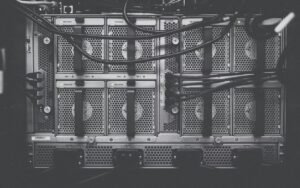AI Regulation
Artificial Intelligence (AI) is rapidly transforming various sectors, from healthcare and finance to transportation and entertainment. As AI continues to advance, concerns have arisen regarding its responsible and ethical use. In response, governments and organizations around the world are actively developing regulations to govern the development, deployment, and use of AI technologies. AI regulation aims to address issues such as privacy, bias, transparency, accountability, and potential job displacement.
Key Takeaways:
- AI regulation is being developed to address concerns regarding responsible and ethical use of AI technologies.
- Important aspects of AI regulation include privacy, bias, transparency, accountability, and job displacement.
- Regulatory initiatives vary across different countries, with some prioritizing AI development and others focusing on caution.
- Efforts are being made to create international collaborations for consistent AI regulation.
Privacy is a major concern in the era of AI, as it involves the collection, storage, and analysis of vast amounts of personal data. AI regulation aims to protect individuals’ privacy rights and ensure that data is handled securely and in compliance with applicable laws. Transparency is another critical aspect, as it is important to understand how AI systems make decisions. Lack of transparency can lead to bias, discrimination, and potential harm.
Bias in AI algorithms has been a contentious issue, with certain groups being disproportionately affected by biased decision-making. AI regulation seeks to address this issue by ensuring fairness and preventing discrimination in AI-based decision systems. Accountability is also a crucial component of AI regulation, as it determines who is responsible for any harm caused by AI systems. Fostering accountability encourages organizations to develop robust AI systems and be answerable for their impacts.
Recent incidents have highlighted the need for comprehensive AI regulation to prevent potential threats and foster responsible AI development and deployment.
Regulatory Initiatives
Regulatory initiatives regarding AI differ across countries, reflecting various approaches and priorities:
- In the United States, regulation aims to balance innovation and consumer protection while ensuring AI’s responsible use.
- China seeks to become a global leader in AI, and their regulations focus on supporting AI development and applications.
- European Union emphasizes ethical AI and has proposed strict regulations on data protection and transparency.
International Collaboration
Given the global nature of AI, international collaboration is essential for consistent regulation:
- The Global Partnership on Artificial Intelligence (GPAI) brings together leading countries to develop and share best practices in AI regulation.
- The Organization for Economic Cooperation and Development (OECD) is working on developing policy recommendations for responsible AI.
Data on AI Regulation
Tables below present interesting data points related to AI regulation:
| Country | Approach to AI Regulation |
|---|---|
| United States | Balancing innovation and consumer protection |
| China | Supporting AI development and application |
| European Union | Emphasizing ethical AI and strict data protection |
| Organization | Mission |
|---|---|
| Global Partnership on AI (GPAI) | Developing and sharing best practices in AI regulation |
| Organization for Economic Cooperation and Development (OECD) | Developing policy recommendations for responsible AI |
| Privacy | Bias | Transparency | Accountability |
|---|---|---|---|
| Ensures protection of personal data. | Addresses bias in AI decision-making. | Promotes understanding of AI decision-making processes. | Determines responsibility for AI system impacts. |
The Future of AI Regulation
The development and implementation of AI regulation will continue to evolve, adapting to technological advancements and societal changes. As AI becomes increasingly integrated into our lives, regulations will be necessary to strike a balance between innovation and the protection of individuals’ rights. Collaboration between countries and organizations is crucial to foster responsible AI development and ensure consistent regulations worldwide.

Common Misconceptions
Misconception 1: AI regulation stifles innovation
- AI regulation ensures ethical and responsible use of AI technology.
- Regulation can help foster public trust in AI, leading to increased adoption and investment.
- Industry standards and regulations can drive innovation by providing clear guidelines and parameters.
One common misconception surrounding AI regulation is that it hampers innovation. However, this is not entirely accurate. While regulation may introduce certain constraints, it also plays a crucial role in ensuring the ethical development and deployment of AI. By establishing guidelines and rules, regulation helps protect against unintended consequences and potential harm caused by AI systems. Furthermore, regulation can foster public trust in AI, ultimately leading to increased adoption and investment in the technology.
Misconception 2: AI regulation is unnecessary as humans can control AI
- AI systems can rapidly learn and evolve, making it difficult for humans to fully control them.
- Regulation can ensure transparency and accountability in AI decision-making processes.
- AI regulation can prevent or mitigate biases and discrimination inherent in AI systems.
Another misconception is that human control is sufficient to manage AI systems. However, AI technologies are capable of learning and evolving at a rapid pace, often surpassing human capabilities. This makes it increasingly difficult for humans alone to have complete control over AI systems. AI regulation steps in to fill this gap by providing necessary oversight and transparency. By imposing regulations, we can ensure that AI decision-making processes are accountable, avoid biases and discrimination, and minimize potential risks associated with unchecked autonomy.
Misconception 3: AI regulation hampers international collaboration and competitiveness
- International cooperation can lead to harmonized AI regulations, fostering collaboration, and reducing barriers to global deployment.
- Regulation can promote interoperability and standardization, allowing for seamless integration of AI systems across borders.
- Compliance with AI regulations can actually enhance global reputation and trustworthiness for businesses and organizations.
Some argue that AI regulation creates barriers to international collaboration and hampers competitiveness. However, this perspective overlooks the potential benefits of global cooperation in AI regulation. By working together, countries can harmonize their regulations, reducing conflicts and facilitating collaboration in AI research and development. Moreover, regulation can promote interoperability and standardization, enabling the seamless integration of AI systems across national borders. Ultimately, compliance with AI regulations can enhance the global reputation and trustworthiness of businesses and organizations operating in this domain.
Misconception 4: AI regulation will eliminate job opportunities
- Regulation can encourage the development of new roles and skills to manage AI systems.
- Effective regulation can prevent job displacement and ensure a responsible transition to AI-driven economies.
- Regulation can support the ethical use of AI in job automation, focusing on enhancing human well-being.
There is a widespread belief that AI regulation will lead to job losses and eliminate employment opportunities. However, this is not necessarily the case. AI regulation can actually encourage the creation of new roles and jobs that revolve around managing and maintaining AI systems or analyzing AI-generated insights. Furthermore, effective regulation can prevent hasty job displacement and promote a responsible transition to AI-driven economies. By focusing on the ethical use of AI in job automation, regulation can ensure that AI technologies enhance human well-being and productivity, rather than taking away jobs indiscriminately.
Misconception 5: AI regulation is a one-size-fits-all approach
- Regulation should be adaptable to different AI applications, considering their specific risks and societal impacts.
- A flexible regulatory framework can accommodate different levels of AI system complexity and autonomy.
- Regulation should be periodically updated to keep pace with advancing AI technologies and emerging challenges.
Lastly, it is important to dispel the misconception that AI regulation follows a one-size-fits-all approach. Each AI application holds unique risks and societal impacts, and as such, regulation should be adaptable to these differences. A flexible regulatory framework can accommodate the varying complexity and autonomy levels of different AI systems. Moreover, AI regulation should not remain static; it needs to be periodically updated and revised to keep pace with evolving AI technologies and emerging challenges, ensuring that it remains effective and relevant in an ever-changing landscape.

Artificial Intelligence Regulations by Country
The following table provides an overview of the current state of artificial intelligence regulations in different countries around the world. It outlines the level of regulation implemented, ranging from minimal to comprehensive, and highlights the specific areas covered by these regulations.
| Country | Level of Regulation | Areas Covered |
|---|---|---|
| United States | Minimal | Data privacy |
| China | Comprehensive | Data privacy, algorithm transparency |
| European Union | Medium | Data privacy, liability, transparency |
| Canada | Low | Data privacy, ethical guidelines |
| Germany | Medium | Data privacy, transparency, accountability |
The Impact of AI on Job Market
This table examines the projected impact of artificial intelligence on the job market over the next decade. It presents the estimated number of jobs that may be automated, categorized by different industries, and provides insights into potential job growth areas.
| Industry | Jobs at Risk of Automation | Potential Job Growth Areas |
|---|---|---|
| Retail | 2.1 million | AI programming, customer experiences |
| Transportation | 1.5 million | Autonomous vehicles, logistics management |
| Healthcare | 1.7 million | Telehealth, medical AI research |
| Manufacturing | 2.2 million | Robotics engineering, quality control |
| Finance | 1.4 million | Data analysis, fintech development |
Public Perception of AI
This table illustrates the public perception of artificial intelligence across different age groups. Surveys were conducted to understand individuals’ attitudes and concerns regarding AI technology.
| Age Group | Positive Perception | Negative Concerns |
|---|---|---|
| 18-24 | 82% | Job displacement, privacy invasion |
| 25-34 | 75% | Security vulnerabilities, lack of human touch |
| 35-44 | 67% | Ethical dilemmas, bias in decision-making |
| 45-54 | 59% | Loss of control, exacerbation of inequality |
| 55+ | 43% | Robotic takeover, impact on social interactions |
AI Startups Funding by Region
This table provides an overview of the funding obtained by artificial intelligence startups in different regions globally. It reflects the monetary investments made in AI ventures and highlights the leading regions supporting AI innovation.
| Region | Total Funding (in billions) | Leading AI Companies |
|---|---|---|
| North America | 45.6 | OpenAI, Waymo |
| Europe | 23.8 | DeepMind, UiPath |
| Asia-Pacific | 18.3 | SenseTime, Megvii |
| Middle East | 2.1 | Viisights, Beyond Verbal |
| Africa | 0.7 | InstaDeep, Aerobotics |
AI in Art and Creativity
This table showcases the implementation of artificial intelligence in various artistic disciplines, including music, visual arts, and literature. It explores how AI algorithms are enriching and transforming the artistic landscape.
| Artistic Discipline | AI Applications | Noteworthy Examples |
|---|---|---|
| Music | AI composition, virtual bandmates | Aiva, Amper Music |
| Visual Arts | AI-assisted painting, generative art | DeepArt, Google’s DeepDream |
| Literature | AI-based storytelling, automated content generation | ChatGPT, Heliograf |
| Film | AI-powered video editing, script analysis | ScriptBook, Magisto |
| Dance | AI-choreographed performances, movement analysis | Aura, ChoreoGraph |
AI Ethics Principles
This table presents a summary of the ethical principles proposed for governing the development and deployment of artificial intelligence. These principles aim to ensure responsible and accountable AI practices.
| Principle | Description |
|---|---|
| Transparency | AI systems should be explainable and disclose sources of data. |
| Fairness | AI should not cause or perpetuate unfair discrimination or biases. |
| Privacy | AI must respect and protect individuals’ privacy rights. |
| Accountability | Those responsible for AI systems should be accountable for their outcomes. |
| Safety | AI should be developed and deployed in a safe and secure manner. |
AI Adoption in Education
This table explores the integration of artificial intelligence technologies in educational institutions. It examines the adoption of AI-driven tools for personalized learning, assessments, and student support.
| Application | Benefits | Examples |
|---|---|---|
| Personalized Learning | Adaptive curriculum, individualized feedback | DreamBox, Knewton |
| Automated Assessments | Efficiency, immediate feedback | EdX, Proctorio |
| Virtual Assistants | 24/7 support, answering student queries | IBM Watson Assistant, Jill Watson |
| Learning Analytics | Data-driven insights, early intervention | AltSchool, Civitas Learning |
| Tutoring Chatbots | Accessible help, personalized guidance | Woebot, Gradescope |
AI in Climate Change Research
This table outlines the role of artificial intelligence in climate change research and mitigation strategies. It showcases AI applications for climate modeling, renewable energy optimization, and environmental monitoring.
| Application | AI Contribution | Benefits |
|---|---|---|
| Climate Modeling | Prediction accuracy, scenario simulations | Improved climate projections, informed policies |
| Renewable Energy | Optimized production, distribution efficiency | Increased renewable energy adoption, cost savings |
| Environmental Monitoring | Monitoring data analysis, anomaly detection | Early warning systems, targeted interventions |
| Adaptation Strategies | Risk assessment, resilience planning | Informed decision-making, reduced vulnerability |
| Emission Reduction | Process optimization, smart grid management | Lower carbon footprint, energy conservation |
In conclusion, the regulation of artificial intelligence varies across countries, with differing levels of focus on data privacy, transparency, and ethical guidelines. The impact of AI on the job market is expected to automate certain roles while creating new job opportunities in AI-related fields. Public perception of AI varies among age groups, with concerns ranging from job displacement to loss of control. Funding for AI startups is predominantly concentrated in North America, Europe, and Asia-Pacific. AI is also increasingly being integrated into artistic disciplines, education, climate change research, and other domains, offering new possibilities and challenges. As AI continues to evolve, striking the right balance between innovation and responsible governance remains crucial.
Frequently Asked Questions
1. What is AI regulation?
AI regulation refers to the rules, guidelines, and policies put in place to govern the development, deployment, and use of artificial intelligence technologies. It aims to ensure that AI systems are used responsibly, ethically, and in a way that aligns with societal values and priorities.
2. Why is AI regulation important?
AI regulation is important to address concerns related to privacy, bias, transparency, accountability, and safety in AI systems. With the rapid advancement of AI technologies, it is crucial to establish a regulatory framework that promotes innovation while mitigating potential risks and unintended consequences.
3. Who is responsible for AI regulation?
AI regulation is typically the responsibility of government bodies, regulatory agencies, and policy-making institutions. They work closely with experts from various fields, including technology, ethics, law, and social sciences, to develop and enforce appropriate regulations.
4. What are the key considerations in AI regulation?
Key considerations in AI regulation include privacy protection, data governance, algorithmic transparency, fairness and non-discrimination, safety and risk management, accountability, and the ethical implications of AI systems. These considerations aim to strike a balance between innovation and societal well-being.
5. How are AI systems regulated internationally?
AI regulation varies across countries and regions. Some countries have established specific regulatory bodies or enacted laws to address AI-related concerns, while others rely on general data protection, consumer protection, and anti-discrimination laws to regulate AI. International collaborations and agreements also play a role in shaping AI regulations globally.
6. What challenges are associated with AI regulation?
Challenges associated with AI regulation include the fast-paced nature of technology development, the complexity of AI systems, the difficulty of anticipating and regulating future advancements, the potential for regulatory capture or biases, the need for interdisciplinary expertise, and striking a balance between innovation and regulation.
7. What are the potential benefits of AI regulation?
AI regulation can help build public trust in AI technologies, foster ethical practices, ensure fair competition, protect individual privacy rights, prevent algorithmic biases, promote safety and risk reduction, and encourage responsible innovation. It also provides clarity and guidance for organizations working with AI systems.
8. How does AI regulation impact businesses?
AI regulation can impact businesses by imposing compliance requirements, mandating transparency and accountability measures, influencing market dynamics, shaping consumer expectations, and potentially limiting certain uses of AI technologies. However, it can also provide a level playing field, create new business opportunities, and foster innovation through responsible practices.
9. How can individuals contribute to AI regulation?
Individuals can contribute to AI regulation by voicing their concerns, engaging in public consultations and policy discussions, advocating for ethical and responsible AI practices, participating in interdisciplinary research, and staying informed about AI-related developments and regulatory initiatives.
10. What does the future of AI regulation look like?
The future of AI regulation is likely to involve ongoing discussions, collaborations between stakeholders, iterative updates to regulations as technology evolves, international partnerships, ethical frameworks, stronger enforcement mechanisms, and greater emphasis on interdisciplinary approaches to address AI-related challenges.




